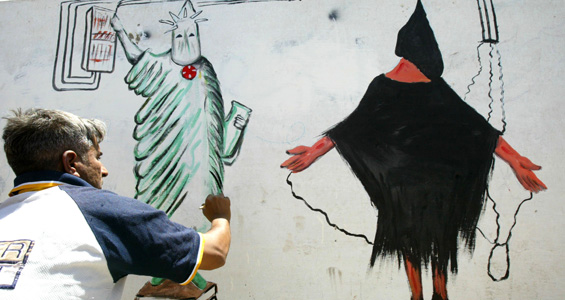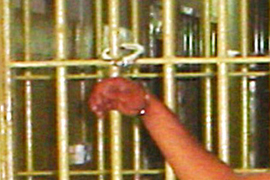Fight to release Abu Ghraib images
Disclose remaining secret images taken in Abu Ghraib for a safer US, says campaigner.

 |
| Pictures depicting prisoner abuse in Abu Ghraib prison sparked global outrage [GALLO/GETTY] |
In September 2008, an appellate court composed of three judges appointed by both Democratic and Republican presidents ordered the government to disclose photographs depicting detainees being abused in US custody.
The court rejected as too speculative an argument by the administration of George Bush, the former US president, that the pictures should be suppressed in order to prevent anti-US sentiment and protect US soldiers from any violence that might be inflamed by their release.
Now, a year later, and despite the court’s ruling, – and much to our profound disappointment at the American Civil Liberties Union – Barack Obama, the US president, has vowed to continue to suppress the photos.
The president should reverse course and embrace transparency.
As the appellate court recognises: “There is a significant public interest in the disclosure of these photographs.”
They are critical to a full and informed understanding of the interrogation and detention policies of the Bush administration.
Rogue soldiers
Releasing the pictures to the public would serve to rebuke the myth, perpetuated by the Bush administration and recently repeated by Obama himself, that rogue soldiers are responsible for the abuse.
And, perhaps most importantly, the pictures would illustrate in ways no words could the consequences of the Bush administration’s unlawful detention and interrogation regime.
|
Pictures… have a unique ability to transform public debate. It was the video of the Rodney King beating that exposed racial tensions in Los Angeles |
Pictures, especially controversial ones, have a unique ability to transform public debate.
It was the video of the Rodney King beating by police in 1991, for example, that exposed racial tensions in Los Angeles.
It was the images of the Twin Towers burning and collapsing in New York that conveyed to the country, and the world, the unspeakable horrors of that day in a way words never could.
And it was the iconic picture of a man, hooded, wired and balanced on a cardboard box at the Abu Ghraib prison in Iraq, that signalled to our nation that our counter-terrorism policies had strayed far from our core values.
Just weeks ago, the president himself recognised the transformative power of pictures.
While addressing the post-election unrest in Iran, he noted that he had seen the amateur video of an Iranian woman – Neda – dying after being shot in the chest.
The video has come to symbolise Iran’s oppressive response to recent political protest.
President Obama was moved by what he saw: “It’s heartbreaking. And I think that anybody who sees it knows that there’s something fundamentally unjust about that.”
Inflame anti-US sentiment?
To the president, however, there is apparently a difference between images of America’s and other countries’ abuse.
Releasing the photographs would, he says, “inflame anti-American opinion and put our troops in greater danger”.
These photos would certainly be disturbing and no one wants to endanger our troops.
 |
| Only low-level individuals have so far been held to account over the abuse at Abu Ghraib[AP] |
But the president is wrong to suppress the images.
In rejecting the same argument put forward by the Bush administration, the appellate court noted that the risk that the release of the photographs would endanger our troops is “speculative” and the possibility that it would endanger any particular solider is “minuscule”.
The court’s analysis should sound familiar, because it was Obama himself who declared on his second day in office that information should not be suppressed based on “speculative or abstract fears”.
The more fundamental problem with the president’s rationale, however, is that it is unbounded and would justify the greatest suppression of the worst governmental wrongdoing.
To prevent inflaming anti-American opinion, the government would have to suppress all evidence of torture and any discussion of Guantanamo Bay or Abu Ghraib.
That anti-democratic equation, the greatest suppression of the worst misconduct, would forever keep the public in the dark about the facts most important to informed decision-making.
Obama also argued that the images of abuse “would not add any additional benefit” to the debate about detainee treatment.
In the same statement, however, he repeated the myth that the abuse of detainees was aberrational and carried out by rogue soldiers.
‘Expose policy-makers’
To the contrary, the images would expose the abuse as a result of policies approved at the highest levels of government, in part because they document abuse at locations other than Abu Ghraib.
In that respect, the photos would advance the debate, which thus far has failed to sufficiently focus on high-level accountability and which is still permeated by the inaccurate “bad apple” explanation.
To date, the only individuals held accountable for unlawful abuse are low-level implementers of policies, not the policy-makers themselves.
Of course, the biggest political consideration for the president might be that transparency and accountability march hand in hand.
As more and more evidence of executive excess under the Bush administration amasses, calls for some form of accountability will become louder and more resolute.
Obama’s apparent desire to sidestep this thorny issue ignores the need for, and inevitability of, full transparency and accountability.
In America, nothing remains a secret forever, and the sooner we investigate and publicly acknowledge past abuses, the safer, freer and stronger we will be as a nation.
Alexander Abdo is a legal fellow at the National Security Project of the American Civil Liberties Union.
The opinions expressed in this article are the author’s own and do not necessarily reflect Al Jazeera’s editorial policy.